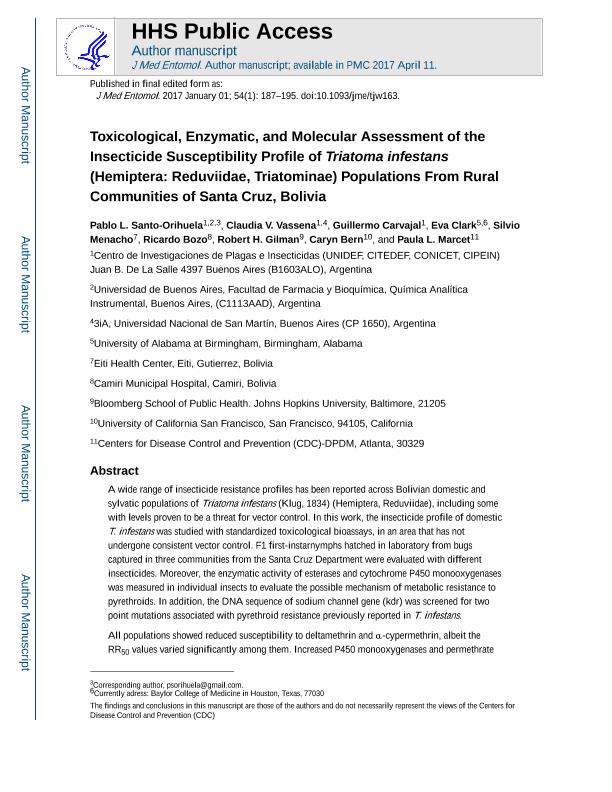Artículo
Toxicological, enzymatic, and molecular assessment of the insecticide susceptibility profile of triatoma infestans (Hemiptera: Reduviidae, Triatominae) populations from rural communities of Santa Cruz, Bolivia
Santo Orihuela, Pablo Luis ; Vassena, Claudia Viviana
; Vassena, Claudia Viviana ; Carvajal, Guillermo
; Carvajal, Guillermo ; Clark, Eva; Menacho, Silvio; Bozo, Ricardo; Gilman, Robert H.; Bern, Caryn; Marcet, Paula Lorena
; Clark, Eva; Menacho, Silvio; Bozo, Ricardo; Gilman, Robert H.; Bern, Caryn; Marcet, Paula Lorena
 ; Vassena, Claudia Viviana
; Vassena, Claudia Viviana ; Carvajal, Guillermo
; Carvajal, Guillermo ; Clark, Eva; Menacho, Silvio; Bozo, Ricardo; Gilman, Robert H.; Bern, Caryn; Marcet, Paula Lorena
; Clark, Eva; Menacho, Silvio; Bozo, Ricardo; Gilman, Robert H.; Bern, Caryn; Marcet, Paula Lorena
Fecha de publicación:
01/2017
Editorial:
Entomological Society of America
Revista:
Journal of Medical Entomology
ISSN:
0022-2585
Idioma:
Inglés
Tipo de recurso:
Artículo publicado
Clasificación temática:
Resumen
A wide range of insecticide resistance profiles has been reported across Bolivian domestic and sylvatic populations of Triatoma infestans (Klug, 1834) (Hemiptera, Reduviidae), including some with levels proven to be a threat for vector control. In this work, the insecticide profile of domestic T. infestans was studied with standardized toxicological bioassays, in an area that has not undergone consistent vector control. F1 first-instar nymphs hatched in laboratory from bugs captured in three communities from the Santa Cruz Department were evaluated with different insecticides. Moreover, the enzymatic activity of esterases and cytochrome P450 monooxygenases was measured in individual insects to evaluate the possible mechanism of metabolic resistance to pyrethroids. In addition, the DNA sequence of sodium channel gene (kdr) was screened for two point mutations associated with pyrethroid resistance previously reported in T. infestans. All populations showed reduced susceptibility to deltamethrin and α-cypermethrin, albeit the RR50 values varied significantly among them. Increased P450 monooxygenases and permethrate esterases suggest the contribution, as detoxifying mechanisms, to the observed resistance to deltamethrin in all studied populations. No individuals presented either mutation associated to resistance in the kdr gene. The level of susceptibility to α-cypermethrin, the insecticide used by the local vector control program, falls within an acceptable range to continue its use in these populations. However, the observed RR50 values evidence the possibility of selection for resistance to pyrethroids, especially to deltamethrin. Consequently, the use of pyrethroid insecticides should be closely monitored in these communities, which should be kept under entomological surveillance and sustained interventions.
Palabras clave:
Esterase
,
Insecticide
,
Pyrethroid
,
Resistance
,
Triatoma Infestans
Archivos asociados
Licencia
Identificadores
Colecciones
Articulos(UNIDEF)
Articulos de UNIDAD DE INVESTIGACION Y DESARROLLO ESTRATEGICOS PARA LA DEFENSA
Articulos de UNIDAD DE INVESTIGACION Y DESARROLLO ESTRATEGICOS PARA LA DEFENSA
Citación
Santo Orihuela, Pablo Luis; Vassena, Claudia Viviana; Carvajal, Guillermo; Clark, Eva; Menacho, Silvio; et al.; Toxicological, enzymatic, and molecular assessment of the insecticide susceptibility profile of triatoma infestans (Hemiptera: Reduviidae, Triatominae) populations from rural communities of Santa Cruz, Bolivia; Entomological Society of America; Journal of Medical Entomology; 54; 1; 1-2017; 187-195
Compartir
Altmétricas



